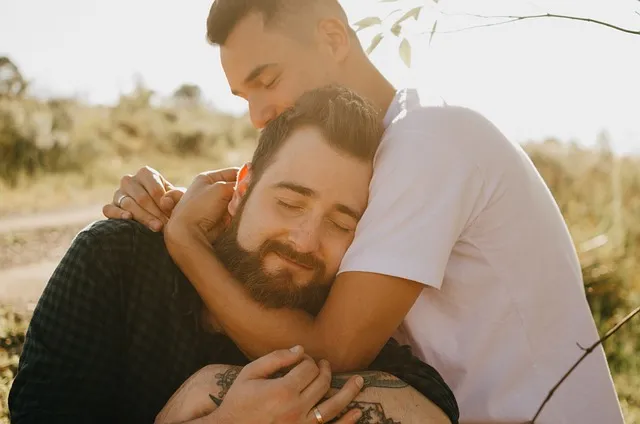How to Securely
Relate and Create
a Healthy
Attachment After
Sexual Abuse
Sep 19, 2023 | By: Hope for the Journey
Relationships can be tough, especially when we carry emotional baggage from past experiences. Childhood sexual abuse can be really heavy baggage that impacts our relationships for years in small and dramatic ways unless we heal from the past. Our attachment style and the way we relate to our partners can sometimes be rooted in childhood experiences. These attachment wounds can disrupt our ability to connect with our partners and cause us to experience a range of negative emotions, including anxiety and insecurity. However, with effort and dedication, it is possible to move past these wounds and create a secure healthy attachment in our relationships. In this blog post, we will explore how couples can securely relate in their relationship and heal attachment wounds.
Secure Relating Tip #1: Understand Your Attachment Style
The first step in healing attachment wounds is to understand your attachment style. Your attachment style is a pattern of behavior developed in childhood that affects the way you relate to others. There are three main attachment styles: secure, anxious, and avoidant. Understanding your attachment style can help you recognize your patterns of behavior and how they affect your relationships. If you identify with an insecure attachment style, it is important to learn about it and work on cultivating a more secure healthy attachment.
Secure Relating Tip #2: Be Vulnerable
Vulnerability is a key element in building a secure attachment. Being vulnerable means opening up to your partner and sharing your true self. In a secure relationship, partners can share their fears, doubts, and insecurities without any judgment. When partners feel safe enough to be vulnerable, they create a stronger emotional connection with each other. However, vulnerability is not always easy, and it requires a certain level of trust. It is important to start small and take baby steps towards vulnerability, and trust will gradually develop over time.
Secure Relating Tip #3: Learn to Validate
Validation is the act of acknowledging and accepting your partner’s feelings and experiences. In a secure relationship, partners validate each other’s emotions and feelings. Validation helps create empathy, and it allows partners to feel seen and heard. However, it’s important to remember that validation does not mean agreement. You can validate your partner’s feelings without agreeing with their point of view. Learning to validate your partner’s emotions can help build a strong foundation of trust and understanding.

Mindfulness
Mindfulness is the practice of being present in the moment and focusing on the present rather than the past or future. Practicing mindfulness can improve emotional regulation, reduce stress, and improve communication skills. In a relationship, being mindful means being present and attentive to your partner’s needs and paying attention to their nonverbal cues. When partners are mindful, they can communicate more effectively and resolve conflicts with ease.
Secure Relating Tip #3: Practice Mindfulness
Mindfulness is the practice of being present in the moment and focusing on the present rather than the past or future. Practicing mindfulness can improve emotional regulation, reduce stress, and improve communication skills. In a relationship, being mindful means being present and attentive to your partner’s needs and paying attention to their nonverbal cues. When partners are mindful, they can communicate more effectively and resolve conflicts with ease.
Secure Relating Tip #4: Be Consistent
Consistency is a key element in building a secure attachment. Consistency means showing up for your partner and following through on promises. Being consistent allows partners to trust each other and create a sense of safety in the relationship. In a secure relationship, partners feel confident that their needs will be met, and they can rely on each other for support. Consistency requires effort and dedication, but the rewards are worth it.
Conclusion:
Healing attachment wounds and building a secure attachment in a relationship takes time and effort. However, the rewards are tremendous. When partners feel safe, seen, and heard, they create a stronger emotional connection with each other. By understanding your attachment style, being vulnerable, practicing validation, mindfulness, and consistency, you can create a secure attachment and build a strong, healthy relationship. Remember, healing attachment wounds takes time, but with patience and understanding, it is possible to move past them and create a more secure, fulfilling relationship.

Are you or someone you know needing assistance with healing from trauma?
Our team of caring therapists are ready to help you start your healing journey. Our highly skilled clinicians will welcome you with warmth and understanding. This no longer has to feel like taboo or too “scary” to talk about. To start therapy with Hope For the Journey, please follow these simple steps:
- Contact Hope for the Journey
- Meet with acaring therapist
- Start receiving the support you or your teen deserve.
- Begin to Feel, Heal & Thrive!
Other Services Offered At Hope For The Journey
Our team is happy to offer a number of services from our Round Rock and Austin therapy offices. Mental health services include therapy for anxiety and depression, domestic violence, sexual assault, PTSD, and EMDR. Our team also provides support for family members of all ages with counseling for teens and young adults, children and tweens, couples, men, and parents/partners. Contact us today to learn more about our team and community involvement!

